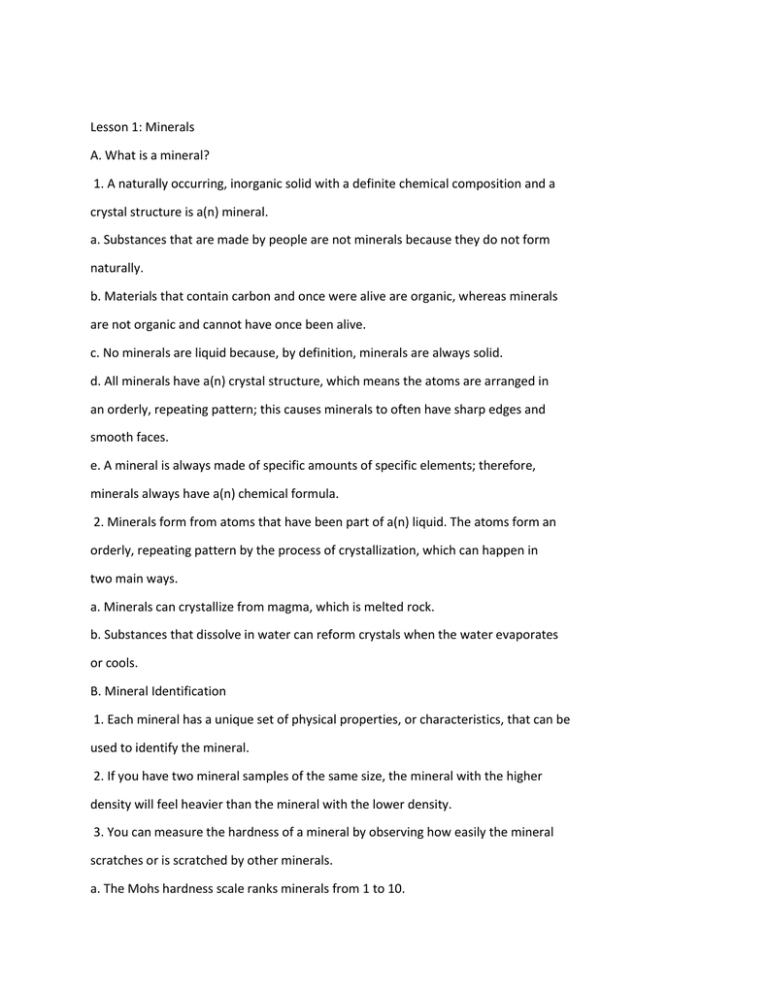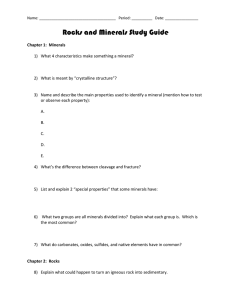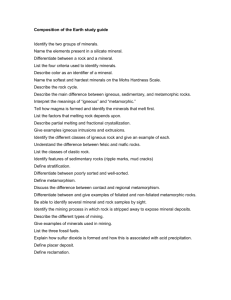answer key for test review - Mater Academy Lakes High School
advertisement

Lesson 1: Minerals A. What is a mineral? 1. A naturally occurring, inorganic solid with a definite chemical composition and a crystal structure is a(n) mineral. a. Substances that are made by people are not minerals because they do not form naturally. b. Materials that contain carbon and once were alive are organic, whereas minerals are not organic and cannot have once been alive. c. No minerals are liquid because, by definition, minerals are always solid. d. All minerals have a(n) crystal structure, which means the atoms are arranged in an orderly, repeating pattern; this causes minerals to often have sharp edges and smooth faces. e. A mineral is always made of specific amounts of specific elements; therefore, minerals always have a(n) chemical formula. 2. Minerals form from atoms that have been part of a(n) liquid. The atoms form an orderly, repeating pattern by the process of crystallization, which can happen in two main ways. a. Minerals can crystallize from magma, which is melted rock. b. Substances that dissolve in water can reform crystals when the water evaporates or cools. B. Mineral Identification 1. Each mineral has a unique set of physical properties, or characteristics, that can be used to identify the mineral. 2. If you have two mineral samples of the same size, the mineral with the higher density will feel heavier than the mineral with the lower density. 3. You can measure the hardness of a mineral by observing how easily the mineral scratches or is scratched by other minerals. a. The Mohs hardness scale ranks minerals from 1 to 10. b. The hardest mineral is diamond, which measures 10 on Mohs hardness scale; the softest mineral is talc, which measures 1 on Mohs hardness scale. T2 Minerals and Rocks 4. Each mineral has a unique streak, which is the color of the mineral’s powder. a. A mineral’s streak can be observed by scratching the mineral across a tile of unglazed porcelain. b. A mineral’s color and its streak sometimes differ. 5. The way the surface of a mineral reflects light is called the mineral’s luster. 6. A mineral displays cleavage if it breaks along smooth, flat surfaces. 7. A mineral’s crystal shape is determined by its atomic structure; large crystals can be useful for identifying a mineral. 8. Some minerals have unusual properties, such as magnetism (the ability to attract ironand steel), electrical conductivity, double refraction, or fluorescence (the ability to glow under ultraviolet light). 9. Many common items are made of metals, which combine with other elements and form minerals; these minerals are usually processed from ores, which are deposits of metallic or nonmetallic minerals that be processed for a profit. Lesson 2: Rocks A. What is a rock? 1. A rock is defined as a naturally occurring solid mixture composed of minerals, organic matter, glass, smaller rock fragments, or any combination of these. 2. The individual particles in rocks are called grains; they give clues about how the rock formed. B. Classifying Rocks 1. Rocks are classified based on how they form. 2. There are three main categories of rocks: igneous rocks, sedimentary rocks, and metamorphic rocks. 3. Most rocks on Earth are igneous rocks. a. Igneous rock forms from molten rock, which is called magma when it is below Earth’s surface and lava after it erupts onto Earth’s surface. b. As the molten rock cools, crystals of minerals start to grow; these become the grains of newly forming igneous rocks. c. Lava at Earth’s surface cools quickly, so the crystals that form are small; geologists describe the texture of igneous rocks with small crystals as fine-grained. d. Magma that is deep below Earth’s surface cools slowly, so the crystals that form have time to grow large. Geologists describe the texture of igneous rocks with crystals of this size as coarse-grained. 4. Rock and mineral fragments that are loose or suspended in water are called sediment and are the source material for sedimentary rock. a. The process by which sediment becomes sedimentary rock is called lithification. b. The grain shape of igneous rocks can be described as rounded or angular. 5. One kind of rock forms when other types of rock are changed due to extreme high temperatures and pressure. The original rock is called parent rock; the resulting rock is metamorphic rock. a. In the process of metamorphism, parent rock is squeezed, heated, or exposed to hot fluid. b. One characteristic of many metamorphic rocks is foliation—the process by which flat minerals line up due to uneven pressures being applied to the rock, giving these rocks, such as gneiss, a layered appearance. C. Rocks in Everyday Life 1. Granite is a(n) igneous rock that is hard and durable, which makes it useful for constructing structures such as fountains; pumice is a soft igneous rock that contains hard glass, which makes it useful for polishing and cleaning. T4 Minerals and Rocks 2. Sedimentary rocks, such as sandstone and limestone, are naturally layered, and so they make good building stones; limestone is a(n) sedimentary rock that is used to make cement. 3. Metamorphic rocks that are foliated split into flat pieces; for example slate is used as a durable, fireproof stone for roofing; marble is a(n) metamorphic rock that is soft enough to carve for in detailed sculptures Lesson 3: The Rock Cycle A. What is the rock cycle? 1. Recycling of rock material occurs naturally on Earth. 2. The rock cycle is the series of processes that continually change one rock type into another. B. Processes of the Rock Cycle 1. The formation of minerals or rocks are key processes of the rock cycle. 2. Igneous rock forms from melted rock that is on or below Earth’s surface. a. Extrusive rock forms when lava erupts, cools, and crystallizes on Earth’s surface. b. Intrusive rock forms when magma cools and crystallizes inside Earth. c. Both extrusive and intrusive rock are igneous rock. 3. Uplift is the process that moves large amounts of rock up to Earth’s surface and to higher elevations. 4. Uplift is driven by the movement of tectonic plates and is related to the building of mountains. 5. At Earth’s surface, rock is subject to the environment. a. Rock is weathered by wind, rain, glaciers, and the activities of some organisms (or living things); these processes break down exposed rock into sediment. b. Sediment is moved by erosion—the process by which glaciers, rain, and wind carry sediment to low-lying places called basins. 6. The process of laying down sediment in a new location is called deposition; over time, deposition causes layers of sediment to form, one on top of the other. 7. In the process of compaction, the weight of upper layers of sediment on lower layers of sediment pushes the grains of the bottom layers closer together. a. There are tiny spaces called pores between the grains of sedimentary rock. b. When there is water containing dissolved minerals in the pores between sediment, the minerals can crystallize, which helps cement the grains together in sedimentary rock. 8. Below Earth’s surface, rocks are sometimes subject to high temperatures and pressures, which cause them to undergo metamorphism. a. With high enough temperatures, the metamorphic rock can melt and become magma. b. When the magma cools and solidifies, igneous rock forms, and another turn of the rock cycle begins. T6 Minerals and Rocks C123_082_087_CRF_AnsOut_892476.i86 86 123_082_087_CRF_AnsOut_892476.i86 86 11/2/10 11:56:41 1/2/10 11:56:41 Copyright © Glencoe/McGraw-Hill, a division of The McGraw-Hill Companies, Inc. 9. The movement of Earth’s tectonic plates helps drive the rock cycle. a. Volcanoes form near plate boundaries, giving rise to igneous rock; this kind of rock also forms where plates move apart. b. Rocks near colliding plates are often exposed to high pressure, which causes them to undergo metamorphism. c. When plates collide, one plate can get pushed deep below Earth’s surface, where the rock melts and becomes magma; in time, it is likely to become igneous rock. d. Colliding plates can push rock to Earth’s surface; such rock is subject to erosion, which breaks the rock into sediment. These pieces of rock can eventually form sedimentary rock.



